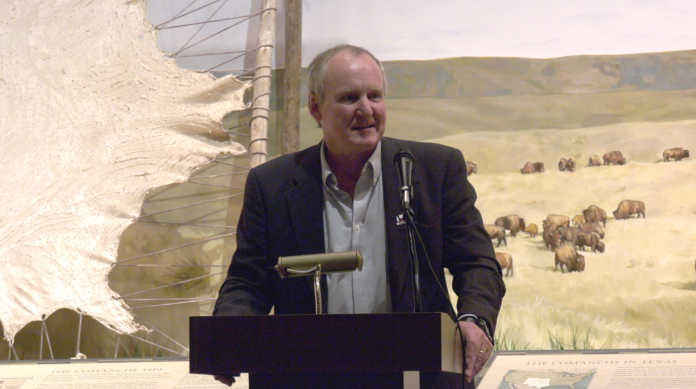
By Mariah Bennett | Staff Writer
Dr. Clarke Wernecke, executive director of the Gault School of Archaeological Research, kicked off the Native American Heritage Speaker Series at 3 p.m. on Wednesday in the Texas Lifeways exhibit of the Mayborn Museum Complex.
In celebration of Native American Heritage Month, the three-part series is being hosted by the Mayborn Museum in collaboration with Baylor’s Department of History and The Texas Collection.
The first part of the series included an introduction and biography of Wernecke and his work with the Gault School of Archaeological Research. The school is a nonprofit organization created in 2006 to protect the Gault site — an archaeological site in Florence that first began having excavations in 1929.
The event, entitled “The Gault Site & the Peopling of the Americas,” discussed new research findings about the first peoples of the Americas.
“I think so much research has been coming out the past 10 years, just really challenging some assumptions … about when people were first here on this continent,” Molly Noah, marketing coordinator of the Mayborn Museum, said.
The event was split into two parts. It began with a 20-minute film presentation giving information on the Gault site, continued with a speaking presentation by Wernecke and finished with a Q&A. Attendees were also able to speak to Wernecke afterward.
“The film gives people a framework,” Wernecke said. “It talks a little bit broader about how we do this archaeology and how we figure things out … It gives people an overview.”
According to the Mayborn Museum’s event description, the event discussed new information from sites older than Clovis that challenged hypotheses of the first peoples in the Americas.
“We have been taught for years a story about the people living in the Americas, and recent archaeological investigations — in Texas and elsewhere — have shown that none of it holds any water,” Wernecke said. “People were here a lot earlier.”
According to National Geographic, the Clovis age ranges from around 13,300 to 12,800 years ago. Formerly, artifacts from that time period were known as representing the first peoples in the Americas. However, artifacts found at the Gault site that predated Clovis challenged that, with some tool styles differing greatly from the popular point. In its brochures, the Gault site is described as being 16,000 years old — thousands of years older than the Clovis age.
The Gault site wasn’t the only site containing evidence. Wernecke said that in the Oregon Paisley Caverns in Oregon, 14,000-year-old coprolites — or possibly dried human feces — were found.
Wernecke challenged other popular hypotheses in the beginning of his presentation, such as the concept of a land bridge and the idea that Native Americans primarily hunted mammoths.
“People have been here in Texas probably 30,000 to 35,000 years,” Wernecke said. “They could not have gotten here the way we always thought … They didn’t walk here.”
Dr. Julie Anne Sweet, Baylor history professor and founding member of the Indigenous Peoples’ Advocacy Committee, said the event lays the groundwork for future events.
“They found these points that are older than anything that existed here in the entire country,” Sweet said. “To even have the idea that tens of thousands of years ago there were already people here living, building and creating … is just fascinating.”
Wernecke said the most important thing to know about the first peoples in the Americas is that while they dressed differently or spoke different languages, they were Homo sapiens, just like modern human beings.
“They’re exactly like us,” Wernecke said. “They don’t really think any differently than you.”




